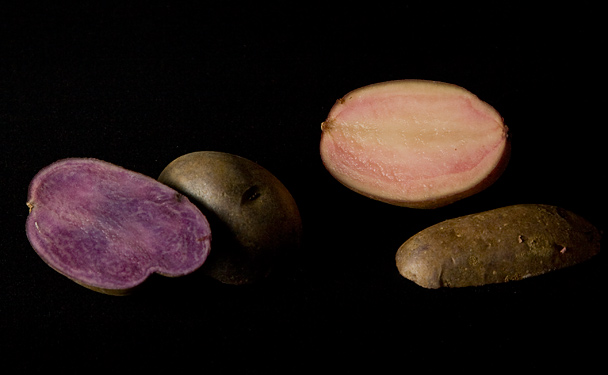When it’s this far into winter, it takes a lot for me to get excited about a potato. Don’t get me wrong: I love potatoes. But by this point in the season I’ve just seen one too many fingerlings on restaurant menus, and have likely eaten half my weight in mashed and fried tubers.
So it was a big deal when, during a recent dinner at New York City’s Astor Center that showcased local farmers and their produce, I fell hard for earthy, deliciously waxy Adirondack Blue potatoes from Sheldon Farms. (It probably helped that the spuds were beautifully roasted by chef Michael Anthony of Gramercy Tavern.) Unlike many of the other colorful varieties out there, these potatoes actually retained their hue—a deep purplish blue, with just the tiniest veins of white—after cooking. The following weekend, when I picked up some Blues from the farmers market (Windfall Farms this time) and panfried them, the outsides took on an appealing light-caramel color as they crisped, while the insides stayed indigo.
There are plenty of great-tasting heirloom potato breeds—nonhybrid varieties that have existed for decades or even centuries—but the Adirondack Blue is different: It’s a comparatively new hybrid, developed by scientists at Cornell University in 2003. And it’s specifically designed to appeal to foodies. For Walter De Jong, the breeder of the Blue—and of a similarly wonderful, if slightly less colorful, potato called the Adirondack Red—culinary quality trumps other agricultural factors like yield and pest-resistance. What’s more, Cornell researchers have worked with culinary students at the CIA and elsewhere to test the Reds and Blues in various dishes, and “we are using chefs’ feedback to develop even better future varieties,” says De Jong.
This is exciting, considering the fact that modern-day potatoes are typically bred not for their taste or their performance in high-end kitchens, but for their ability to be stored for long periods of time or processed into perfect fast-food French fries. The Russet Burbank was long the supreme spud in the States—largely because McDonald’s made its fries from this fluffy, mealy variety. Now breeders are starting to come up with variations on the Russet, but still with an emphasis on “improved adaptation to different growing, storage, or processing conditions.”
Being unusual breeds in today’s tuber world, the Adirondack varieties aren’t available in every farmers market yet; still, the seeds are sold internationally and could theoretically be planted anywhere potatoes are grown (though the Cornell team has only tested them on the East Coast of the U.S.)—so in time, and with enough demand, these varieties could show up at your local farm stand. If you don’t want to wait, mail-order some of the spuds now.
Or you can visit one of a handful of East Coast restaurants where Adirondack Reds and Blues are on the menu—thanks in part to small-scale marketing efforts by farmers like Pat Sheldon of Sheldon Farms, who was the first to send a sample of the potatoes to Anthony at Gramercy Tavern. “To our surprise and delight he loved them,” she says; now he stocks up every week. Adirondack varieties have also been spotted at New York City’s Mas and The Green Table, as well as other restaurants around the region.
I know I’ll get through the rest of root-and-tuber season just fine now; the question is how I’ll preserve enough Reds and Blues to last through the months when potatoes aren’t growing.




 Pinterest
Pinterest


